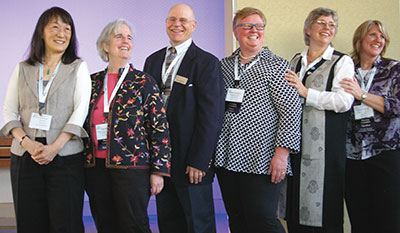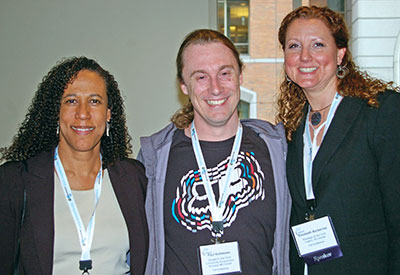
Features
Continuing Education
Education
Mechanisms, Public Health and Planning
Recently, I had the privilege of attending the 2013 International Massage Therapy Research Conference (IMTRC).
June 25, 2013 By Cathy Ryan
Recently, I had the privilege of attending the 2013 International Massage Therapy Research Conference (IMTRC). Before heading into the bounty and beauty of what the conference provided, I feel it is important to acknowledge that the conference was held in Boston just shortly after the horrifying 2013 Marathon bombings. Our hearts go out to all who were affected by this tragic event. Arriving in Boston we did not find a city in turmoil – we were greeted with warmth and kindness, and witnessed the quintessential Bostonian “salt-of-the-earth” calm-strength and resilience. Kudos to Boston and to the staff at the lovely waterfront venue, the Seaport Hotel! What a great city.
 |
|
| Massage Therapy Foundation presidents, previous, current and incoming – left to right: Grace, Chan, Janet R. Kahn, John Balletto, Diana L. Thompson, Ruth Werner and Jerrilyn Cambron.
|
A BIT OF BACKGROUND
This was the third in a continuing series of conferences formerly known as the “Highlighting Massage Therapy in Complementary and Integrative Medicine Research Conference.” The IMTRC is presented by the Massage Therapy Foundation (MTF), which is supported by the American Massage Therapy Association (AMTA). The IMTRC planning committee did a fantastic job of putting together a high-quality event that incorporated ample opportunity to socialize and network along with the planned programming.
The MTF was founded by AMTA in 1990 with the mission of bringing the benefits of massage therapy to the broadest spectrum of society through the generation, dissemination and application of knowledge in this field. Elliott Green (AMTA president at the time) invited Grace Chan (the “Chan” in Canada’s own Sutherland and Chan school of massage therapy) to be the first president of the foundation, and after a bit of deliberation, Grace accepted. She notes, “I decided to do it because it was a very meaningful project and I do enjoy creating something from scratch.” Indeed! Grace, one of our iconic pioneers of Canadian MT education, is well versed in creating something from scratch. She is a grand visionary whose contributions to the profession are far-reaching and enormous!
Many Canadian MTs were in attendance at the IMTRC. Some of us were there to learn and mingle while others graced the planning and scientific advisory committees and some participated as moderators and presenters. Inevitably, every time I attend an international MT related conference, I hear, “Canadian MT education and training, wow! We are so envious, you are so lucky.” We are very fortunate to have the educational standards we do and our profession is represented well because of it.
This conference provided a substantial amount of valid MT information. Many of the presentations (keynotes, panels, breakouts and workshops) are available for your reading pleasure on the MTF website at http://imtrc2013.conferencespot.org/toc/, http://imtrc2013.conferencespot.org/author/ . Poster presenter reception information is available at http://www.massagetherapyfoundation.org/blog/imtrc-poster-reception/ .
Each day concluded with an end of the day question and answer period (Q&A) – so well attended were these, that a larger room had to be secured for Day 2! The MTF blog has a number of interesting IMTRC posts: http://www.massagetherapyfoundation.org/blog/page/2/ that centre around some of the issues brought up at these sessions.
I heard no complaints about not getting ones money’s worth at this conference!
Three main topics were the focus of this year’s conference: mechanisms, public health and research agenda planning – the remainder of this article will break down how they were presented throughout the conference.
DAY 1: MECHANISMS
Ruth Werner (MTF President and IMTRC planning committee co-chair) kicked off the event with opening remarks – we were encouraged to listen, learn, share and have fun! A heartfelt Native American blessing was provided by Luata Bray, LMP Choctaw Native, and Donna Edmonds Mitchell, Wampanoag Nation of Massachusetts.
Keynote: Mechanisms and Beyond – What is Needed to Prove the Effectiveness of Massage? Jeanette Ezzo LMT, MPH, PhD.
A fabulous, warm and witty speaker, Dr. Ezzo identified four main things to consider:
- How does massage therapy (MT) work (mechanism of action – MOA)?
- Does MT work under controlled conditions (efficacy)?
- Does MT work under everyday/real-life conditions (effectiveness)?
- What does MT effect?
Ezzo emphasized that if outcomes are what really matter to our clients, perhaps generating more robust “effectiveness” research is in order.
Ezzo also touched on one of my “rants” – safety, effectiveness and cost-effectiveness. Ezzo put forth that MT has been shown to be 40 per cent less costly (over longer time frames) than the medical route in treating low back pain (LBP). I commend her for making that important point! Having provincially covered medical care tends to present a facade of “free-care.” But when you really assess dollar-for-dollar (doctor visits, diagnostics/tests, drugs, referral for other care, surgical interventions) versus the cost of a series of MT treatments … you do the math.
Panel Presentations, Breakouts and Workshops
Day 1 programming included: “How Does Massage Work? Potential Mechanisms”; “Basic Science”; “Biological and Psychological Models of Massage”; and “Enhancing the Art of Peer Review: Introduction to Program Evaluation and Massage Therapy for Specific Conditions.”
DAY 2: PUBLIC HEALTH
Keynote: Somatic Empathy – Restoring Community Health with Massage. Leslie Korn, PhD, MPH, NCB, LMHC, RPE.
Dr. Korn masterfully took us on a journey with her seamless and eloquent storytelling style, sharing aspects of her many years of collaborative work within the tribal communities of Mexico and the United States. Korn emphasized the importance of restoring traditional nutritional practices and touch therapies to address the spectrum of issues linked to historical trauma. Korn noted the high incidence of attachment disorders associated with trauma and the alarming association between chronic disease and childhood trauma (70 per cent of those with a history of childhood trauma suffer with chronic disease later in life: Korn termed these “diseases of dissociation”). Within the spectrum of presenting issues Korn suggests that MT can provide many benefits including:
improved body awareness; sense of self; sense of connectedness (socialization); and self-care and self-regulation behaviours. Additionally, Korn noted that body work and movement modalities appear to have a similar effect on depression as anti-depressant drugs. Korn also illustrated all the reasons why MT needs to be more accessible to vulnerable populations.
Panel Presentations, Breakouts and Workshops
Day 2 programming included: “Massage in the Community – Informing Public Health”, “Community-based Massage and Massage for Special Populations”; “Practice-Based Research Methods; Case Reports; and Best Practices Guidelines – Building the Framework and Hospital-based Massage.”
DAY 3 – RESEARCH AGENDA PLANNING
Keynote: Massage in 21st Century Healthcare – Let’s Seize the Moment! Janet R. Kahn, PhD.
Brilliant in her knowledge base and ability to deliver statistical data in a manner that was easy on the ears, Dr. Kahn was quite humorous as well as informative.
 |
|
| Many Canadian RMTs attended the conference. Left to right: CK Andrade (Ontario), Paul Kohlmeier (Manitboa), Beth Barberree (Alberta).
|
Although the sobering statistical data provided by Dr. Kahn was U.S. based, the issues she identified do not stop at the border. Health-care expenditure has risen exponentially; however, there is a growing trend toward shorter and less healthy life spans. In addition to unhealthy lifestyle choices associated with the “paradox of progress,” the quality of the health care being provided and accessibility to quality care are also significant mortality-factors to be considered. Kahn urged that we move away from a sickness-care system and embrace a wellness-care model.
The public’s growing interest in integrated health care has underpinned the increase in CAM- related research. Additionally (in the same vein), governmental agencies, especially policy makers, in the U.S. and Canada are being pushed to recognize the value of CAM and to consider inclusion in future health-care funding. Kahn emphatically stated that the “moment of opportunity” is upon us, emphasizing the value in learning from other countries, the importance of interprofessional collaboration and formulating a research agenda that will position therapeutic massage well for the 21st century … indeed let’s seize the moment!
Panel Presentations, Breakouts and Workshops
Day 3 programming included: “Next Steps in Massage Therapy Research”; and “Massage Therapy Research Agenda Planning.
In conclusion, the overall sense of direction, moving forward, was toward the fact that more massage therapy protocol and dosage studies are needed; there is an ever-increasing need and validation for MT to be provided in hospital (postsurgical care, abdominal and orthopedic and scars related to burns); and MT needs to be more accessible (that is, mainstream).
My final note, this event provided substantial evidence to support the assertion that MTs are especially-special. The people within this profession continuously demonstrate, in a multitude of ways, why we are to be considered leaders in patient-focused care.
I also thoroughly enjoyed spending time with some of my British Columbia MT colleagues, reconnecting with some of my colleagues from Ontario and meeting
colleagues from across the country and beyond. The camaraderie was palpable. I fell in love with the profession all over again!
The next IMTRC will be held in 2016. Consider supporting this important event by attending!
Hip Hip Hooray … AMTA-MA and IMTRC
Members of the Massachusetts chapter of the American Massage Therapy Association (AMTA-MA) graciously gave of their time providing in-chair massage for the conference attendees – a much appreciated and well utilized conference offering. More than $900 in donations collected was gifted to the Massage Therapy Foundation. AMTA-MA, my hat is off to you – a class act!
Sponsor and vendor information can be found at: http://imtrc2013.conferencespot.org/sponsors/sponsors/1
Cathy Ryan, RMT, has maintained a diverse, treatment- oriented massage therapy practice and an extensive postgraduate training roster since 1990. Cathy is a longstanding member of provincial massage therapy associations and has served as a subject matter expert and examiner trainer at the CMTO’s provincial licensing examinations. Currently residing and working in beautiful B.C., Cathy maintains a private practice, teaches and writes massage therapy related material and is the managing editor for TouchU.ca; an online source providing accredited continuing education for touch professionals and students. Cathy can be reached at: cryanrmt@gmail.com or via www.touchu.ca.
Print this page